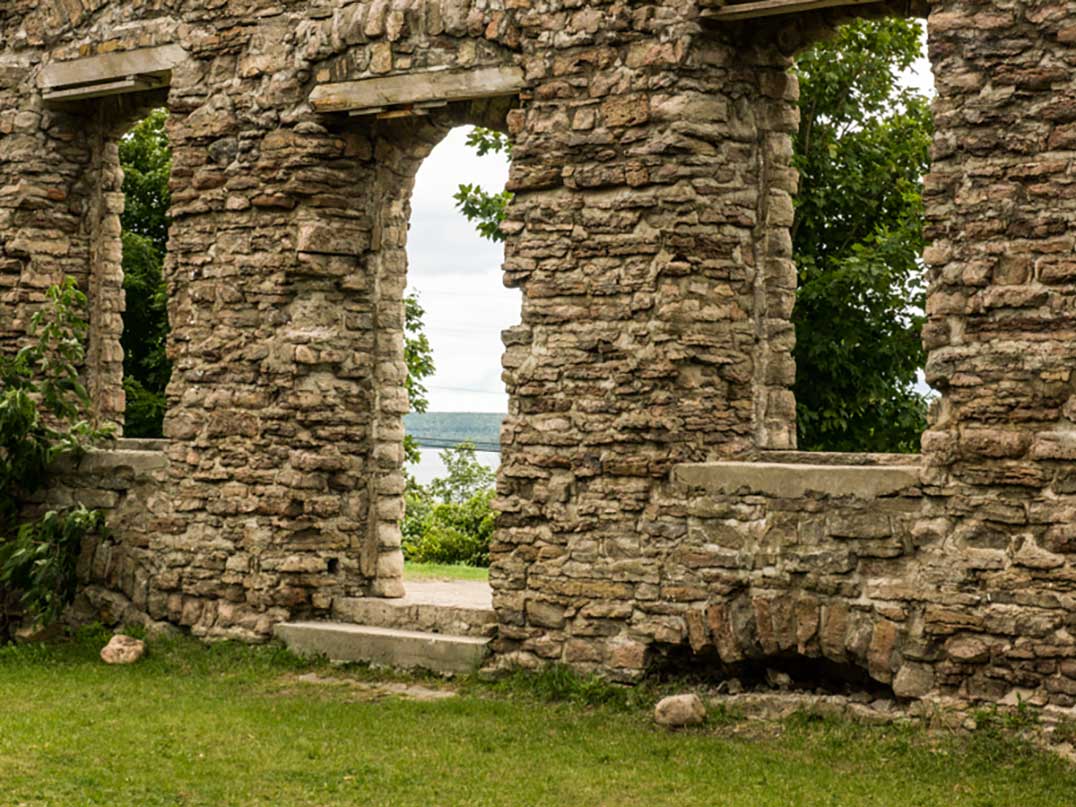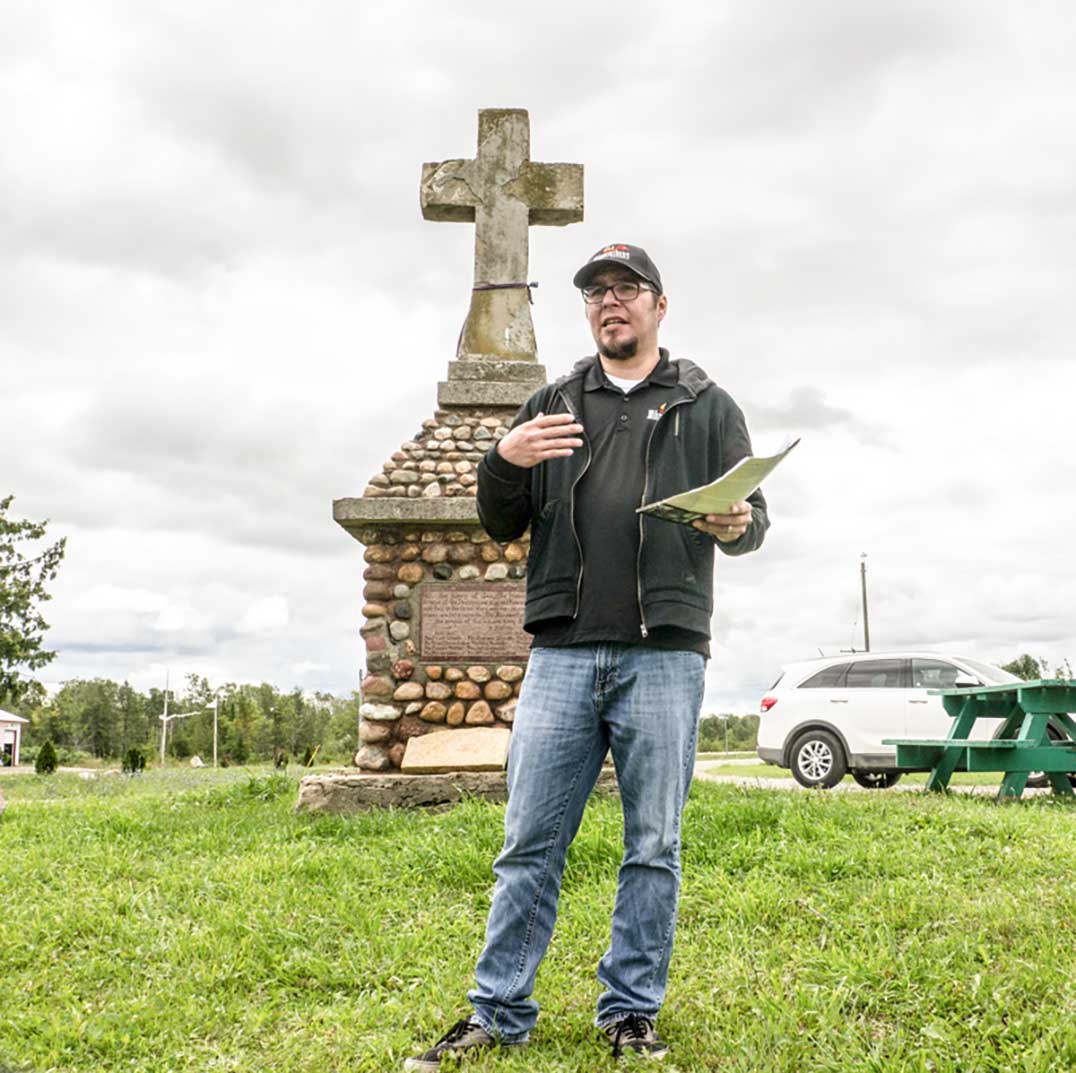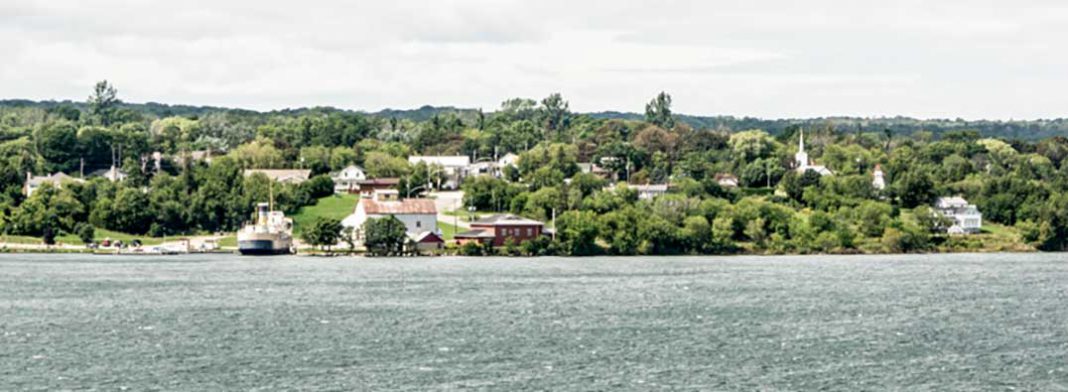by Isobel Harry
WIIKWEMKOONG—In a wooded clearing that is the trailhead for Bebamikawe Memorial Trail in Wiikwemkoong Unceded Territory—formerly known as Wikwemikong Unceded Indian Reserve No. 26 and also known to many as Wiky—small logs smoulder in a firepit of rocks as a hand drum of deer hide stretched on a ring of cedar is warmed over the embers. Craig Fox (with the able assistance of Naomi Mishibinijima and Austin Pangowish) is the teacher, singer and drummer who warms the drums to tighten them while introducing himself—born in Wikwemkoong, Wolf Clan, lives in M’Chigeeng with his wife and family, his drum group is Thunder Road—and soliciting introductions from the assembled participants seated in a semi circle around the fire in the ‘Drum and Song’ Experience of Wikwemikong Tourism.
The information booth and office of Wikwemikong Tourism on Wikwemikong Way (Wikwemkoong’s long main street) is the perfect place to begin an exploration of Manitoulin’s single largest land mass—the territory totals 42,000 hectares and, with Point Grondine’s additional nearly 14,000 hectares near Killarney, is one of the 10 largest First Nation communities in Canada. The Authentic Indigenous Experiences “reflect the cultural lifestyles and traditions of the Anishnaabek people of the Three Fires Confederacy—Ojibwe, Odawa and Pottawatomi—and of the vast lands and waters” of this territory of Wiikwemkoong.
Several Experiences are offered, from an interpretive hike through Bebamikawe Trails with remarkable views of the Niagara Escarpment to a tour of historical sites with educational talks on the 1836 and 1862 treaties of Manitoulin Island, the legend of Zhibzhii the underwater spirit and of the now infamous “Manitoulin Incident.”
The Bay of the Beaver (Manitowaning Bay) Canoe Tour “follows the route of our ancestors to the 17th century Iroquois battle site at Skulls Point and ends at Meeshkodewaang (Prairie Point),” and in Point Grondine, experiences include camping out in an authentic Anishinaabek (Odawa) lodge and hikes to learn “the real, proven and definite side of plant based medicine, not the mystical,” offered by knowledgeable guides.

photos by Isobel Harry
As the smoke rises from the fire, Craig Fox teaches the meaning of the four sacred plants that are part of the Smudging Ceremony: tobacco to channel prayers, cedar for cleansing, sage for calming and purification and sweetgrass to rid negative energy. “I was taught by Joseph Pitawanakwat, a teacher of plant based medicine,” he adds. “Check him out at http://creatorsgarden.blogspot.ca.” The sweet smell of the smoking vessel is passed around the circle, seeming to bathe everyone in an attitude of receptivity.
“There’s a spirit inside that drum,” says our guide as he explains the etiquette around the instrument, from “watching your language” to not allowing any “chaos” from playing children. Then a respectful mood pervades the circle as Craig Fox begins softly to strike the deer hide with cattail-style sticks in the 1-2 heartbeat rhythm familiar to powwow attendees. “This beat is used in the two-step or round dances, with dancers marking the beat in their steps.” Craig’s beautifully trained voice rises to sing a healing song known as the Jingle Dress Song, also sung during a grass dance, which came from the Ojibwe, he says, and is “the newest form of dance at about 100-years-old.” The songs follow each other, haunting, ancient invocations that have served in ceremonies, social events and historical occasions since time immemorial.
A women’s traditional song, the Water Song, is followed by a men’s “traditional sneak-up song,” as Craig Fox laughingly suggests that there should be an “Eighth Grandfather Teaching – Humour!” A pot of water for tea is put on the grate as Craig wraps up with the Three Fires Confederacy Song; several hikers have arrived from the trails, drawn to the circle of people around the fire by the sounds of drum and song floating up the Escarpment through the trees.
The archaeological digs at Sheguiandah and Providence Bay indicate that Manitoulin Island was inhabited perhaps as long as 10,000 years ago; the first recorded contact between these original Island people and French explorers was in 1635 and the Jesuits began their missions in Wiikwemkoong in 1648. Mary Lou Fox, the late founder and director of the Ojibwe Cultural Foundation, has said that in the late seventeenth century, “Nearly all [Manitoulin’s] inhabitants seem to have deserted it. The exact reason for this exodus remains a mystery,” although the most often heard story is of the people setting fire to the woods to “drive out evil spirits that were causing much sickness and troubles.” In the early eighteenth century both Native and non-Native groups began to populate the Island again and in 1833 Odawa from Arbre Croche (Crooked Tree), Michigan, Coldwater, Ontario and places in Quebec settled in Wiikwemkoong.
In 1836, the Bond Head Treaty sought to initiate the migration of Upper Canada Indians to Manitoulin Island where they could live free from the influences of the encroaching white civilization. In 1862, another treaty assigned reserves to the Indigenous population and the rest of Manitoulin Island was sold to non-Natives for settlement. Wiikwemkoong refused to sign and retains its original peninsula territory to this day, Canada’s only officially recognized unceded territory.

participants sit around a fire in a wooded clearing while Craig Fox (standing, right) teaches the significance of the drum in Anishinaabe life, the traditional beats, dances and songs used for millennia in
ceremonies and cultural events.
The deep history of the community is vibrantly portrayed in Wikwemikong Tourism’s ‘Unceded Journey’ Experience with Mitchell Manitowabi as guide—and a few of us accompany him on an enlightening tour that puts the broad sweep of times past into the local context of today.
The population, originally Odawa, with Pottawatomi arriving in 1836 and Ojibwe after 1850, is spread out in several settlements, or satellite communities, including Kaboni, Buzwah, South Bay, Rabbit Island, Murray Hill, Cape Smith, and Wiikwemkongsing, explains Mitchell as we drive to sites with markers planted by the Wikwemikong Heritage Organization to commemorate important historical events and locations. Starting with the view of Manitowaning across the bay, we stand on a lookout platform to hear the story of the first treaty, the setting up of a government Indian administrative centre in Manitowaning, the annual giving of presents that took place there. The span of the water with the little village on the far shore looking very much as it did well over a hundred years ago brings our guide’s tales vividly to life. We visit the Holy Cross Jesuit Mission Church and the ruins of the former school and student residence, impressive still, the three-foot thick stone walls like mute guardians of the community’s beginnings. We finish down by the Marina building, overlooking Smith Bay and the long peninsula of Cape Smith beyond, where the Heritage Organization’s markers tell the story of the community’s iconic whitewashed log homes. “We put that one up specifically because some European visitors had to be convinced that we didn’t live in tipis,” says Mitchell, and of the launching of the first pow wow by Rosemary Fisher in 1960; now the Wiikwemkoong Cultural Festival, it has been a pivotal event in the community’s cultural calendar for 57 years, attracting thousands of visitors from all over the world over the August Civic Holiday weekend. “Powwows were outlawed until the 1950s,” adds Mitchell Manitowabi. “When that ban was lifted, Rosemary, who had been to a pow wow out west, invited some dancers to perform in Wiky.” The fieldstone war memorial topped with a cross on Monument Hill was created in 1930 by Dominic and Jonas Odjig; Mitchell notes that the many crosses that can be seen in Wiikwemkoong were erected after the arrival of the Jesuits.

There is much to see, visit and ponder in Wiikwemkoong Unceded Territory and there are restaurants, accommodations, the enormous shopping complex at Andy’s, the gallery of James Simon Mishibinijima on Lakeshore Road and businesses like Gordie Odjig’s Indianguide Tours and Wasse-Giizhik Tours that specialize in explorations on the water through an Aboriginal lens. Annual events such as the Cultural Festival, the traditional pow wow that rotates through the different communities on Father’s Day weekend (June), the Fall Fair (September), summer productions by internationally-acclaimed Debajehmujig theatre group in the Holy Cross ruins, the Ice Fishing Derby (February), all are compelling introductions to this vibrant community.
An Authentic Indigenous Experience with Wikwemikong Tourism will ground the visitor not only in the land, the people, the plants and animals and water, but will begin a journey of discovery of the culture, customs and traditions of the Anishinaabe worldview.
Two definitve books on the history of Wiikwemkoong Unceded Territory are ‘Balancing Two Worlds’ by Cecil King and ‘Four Voices’ by Shelley J. Pearen; also by Ms Pearen, ‘Exploring Manitoulin’ gives a historical account of Wiikwemkoong and Manitowaning—all are available in the Manitoulin Expositor Bookstore.
The Wikwemikong Tourism info booth is open Monday to Saturday until Labour Day weekend; tours are offered throughout the year. Contact: inquiries@wikwemikong.ca and toll-free telephone: 1-844-945-8687.
For more on Wiikwemkoong Unceded Territory, including business listings and events and the programs of Wikwemikong Tourism, visit www.wikwemikong.ca For Point Grondine Park, see www.grondinepark.com



